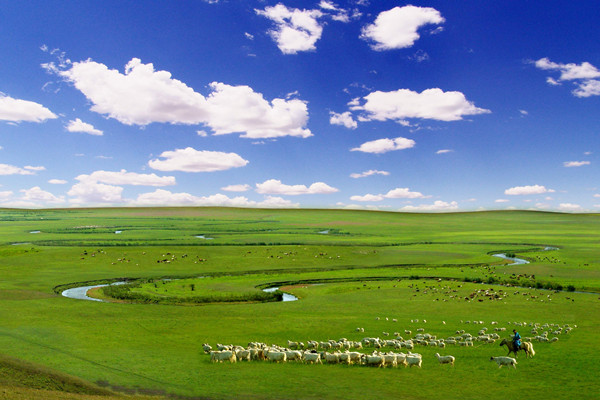Animal husbandry
 |
The grasslands cover about 86.67 million hectares - including 68 million hectares of agricultural grasslands - accounting for one quarter of the country's total. |
Inner Mongolia, with its vast grasslands, is one of China's major bases for husbandry products.
The grasslands cover about 86.67 million hectares - including 68 million hectares of agricultural grasslands - accounting for one quarter of the country's total.
More than 1,000 kinds of forage plants - including about 100 kinds with high feeding value and palatability, such as leymus chinensis, fescue wheatgrass and wild oat - grow in the prairie of the autonomous region, including in Hulunbuir, Xilin Gol, Horqin, Ulanqab, Ordos and Wulate.
The meadow grasslands in northeast Inner Mongolia boast fertile soil, abundant rainfall, and a variety of forage, which provide an ideal environment for livestock breeding, especially cattle. The high nutrition forage on the arid grassland of central and southern Inner Mongolia is good for horses, cattle and sheep, though the species, density and output of forage there are not more than the meadow grassland in northeast..
The desert steppe in the north of Yinshan Mountains and west Erdos Plateau is suitable for breeding small livestock, due to the fat and protein in its forage, in spite of the dry climate and poor species of forage. The desert grassland in the western part of Inner Mongolia is good for raising camels.
Inner Mongolia is known for various livestock, including the Sanhe Hippos, Sanhe Cattle, Red Bulls, Erdos fine-wool sheep and the Arbas Cashmere Goat.
In 2016, the annual numbers of livestock throughout the region reached 135.98 million heads, a 0.1 percent of increase from the previous year. About 78.47 million heads were added for a total gaining rate of 57.8 percent. The numbers of annual fine breeds and improved breeds were 123.98 million heads, accounting for 91.2 percent of the total numbers, with an increase of 0.9 percent from the previous year. The annual meat outputs were 2.59 million tons, a 5.4 percent increase from the previous year, including 0.72 million tons of pork, 0.56 million tons of beef and 0.99 million tons of mutton, increasing 1.8 percent, 5.1 percent and 6.9 percent respectively. The outputs of milk and eggs reached 7.34 million and 0.58 million tons, with a decrease of 8.6 percent and increase of 2.8 percent respectively.
By the end of 2016, machinery gross power in agriculture and animal husbandry reached 33.31GW - an increase of 6.1 percent from the previous year, and the comprehensive mechanization level reached 82.5 percent.



 Print
Print Mail
Mail




